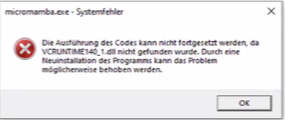RCC Troubleshooting
RCC is the command line tool used to build Python environments for the Robotmk Framework. The practical advantage of this is that it can be used both during test development and during execution by Robotmk. This ensures that the scripts always run in a reliable environment.
However, errors can sometimes occur when building or activating the environments.
This article summarizes the most common sources of errors when working with RCC and shows how to fix them efficiently.
General errors
User Profile with spaces
Error: RCC returns an error with every call:

Description: For unknown reasons, the user profile must not contain spaces.
Solution: Change the path where RCC should store the environments:
- Define a new environment variable
ROBOCORP_HOMEand assign it a directory of your choice (without spaces). Example:C:\rcc - Start a new CMD and try again.
Environment creation
Environment creation fails (VCRUNTIME140_1.dll)
On some Windows systems, the DLL VCRUNTIME140_1.dll is missing (the reason for this is unknown). The tool micromamba used to build the environments aborts the environment creation with a meaningless message:

The cause can be verified by manually executing the tool micromamba.exe listed in the RCC output on the console. If the DLL is actually missing, micromamba generates this error message:

On Windows 11 systems, the error also appears with the error code 0xc0000135:
Fatal [Micromamba [3221225781/c0000135]]: exit status 0xc0000135
Solution: Install the Microsoft Visual C++ Redistributable from Microsoft—it contains exactly this DLL.
Long Path Support
Error: When activating the required LongPath Support with rcc config longpaths -e, this error message appears:
WARNING! Long path support failed. Reason: exit status 1. WARNING! Long paths do not work!
Error executing: rcc.exe configure longpaths --enable
Error code: undefined Error: error Stderr: Failure to modify registry: Access is denied.
Description: Obviously, the Windows machine is centerally managed via Group Policies, which prevents the LongPath support policy from being changed.
Solutions: Ask your administrator responsible for the GPOs to approve this policy:
Local Computer Policy > Computer Configuration > Administrative Templates > System > Filesystem > NTFS > Enable Win32 long paths > Enabled
Restricted Network Access (Proxy)
Error: During the environment creation, RCC fails because of network errors.
Description: RCC requires Internet access to download the installation files and packages.1
If a proxy server must be used, it must be specified in a “Profile”.
Solution:
- First, download the profile template file from here and save it somewhere on your file system.
- Open the file with an editor of your choice and specify the proxy in
http_proxyandhttps_proxy. (Protocol and port also must be included)
Example:
| |
- Next, execute the following commands to import and activate the profile.
> rcc config switch # show the current profile (default)
> rcc config import -f <file>.yaml # import the proxy profile
> rcc config switch -p <profile_name> # switch to the new profile
Switching back to the default profile (= no proxy) is possible withrcc config switch --noprofile.
Note: The approach described above only works if the proxy used allows all domains in principle/as far as possible → this is called a “transparent” or “open” proxy.
So-called “whitelisting” proxies are more restrictive: they have a list of permitted domains; all other data traffic is blocked by default.
If this is the case for you, you must ask the proxy admin to add the following domains to the whitelist:
anaconda.org
conda.anaconda.org
files.pythonhosted.org
pypi.org
registry.npmjs.org
playwright.azureedge.net
playwright-akamai.azureedge.net
playwright-verizon.azureedge.net
github.com
githubusercontent.com
raw.githubusercontent.com
from Checkmk 2.4, also the import of environments as a ZIP file is supported. ↩︎

